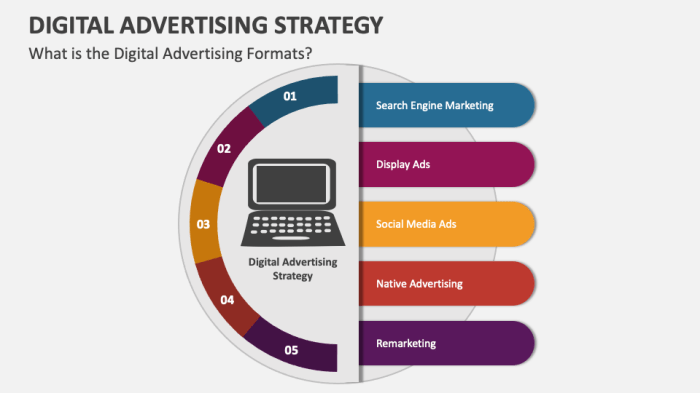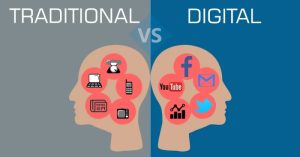
Embark on a digital marketing journey with our guide to Digital advertising strategies, filled with tips and examples to boost your online visibility and engagement.
From targeting specific audiences to creating compelling ad content, this comprehensive overview will help you navigate the world of digital advertising with ease.
Digital Advertising Strategies
In today’s digital age, digital advertising plays a crucial role in reaching and engaging with target audiences. With the rise of online platforms and social media, businesses can utilize various strategies to promote their products or services effectively.
Importance of Digital Advertising
Digital advertising allows businesses to reach a global audience, increase brand awareness, drive website traffic, generate leads, and ultimately boost sales. By leveraging digital channels such as social media, search engines, and display ads, companies can target specific demographics, interests, and behaviors to maximize their advertising efforts.
Examples of Successful Digital Advertising Campaigns
- Nike’s “Just Do It” campaign that focused on empowering athletes and individuals to push their limits.
- Coca-Cola’s “Share a Coke” campaign that personalized their packaging with customers’ names, creating a personalized connection.
- Airbnb’s “We Accept” campaign that highlighted their commitment to diversity and inclusion.
Targeting Specific Audiences through Digital Advertising
To target specific audiences, businesses can use tools like Google Ads, Facebook Ads Manager, and LinkedIn Ads to create custom audience segments based on demographics, interests, behavior, and location. By tailoring ad content to resonate with the target audience, companies can increase engagement and conversion rates.
Tips for Creating Engaging Digital Ad Content
- Use compelling visuals and videos to capture attention.
- Craft concise and impactful ad copy that highlights the unique selling points.
- Include a clear call-to-action (CTA) to prompt viewers to take the desired action.
- Test different ad formats, messaging, and targeting strategies to optimize performance.
Marketing E-Commerce
In today’s digital landscape, the relationship between marketing and e-commerce is crucial for businesses looking to thrive online. E-commerce marketing involves strategies and techniques that drive traffic, conversions, and sales on online platforms. Digital advertising plays a pivotal role in this realm by enabling businesses to reach their target audience effectively and drive engagement and conversions.
Role of Digital Advertising in E-Commerce Marketing
Digital advertising is essential for e-commerce marketing as it allows businesses to target specific audiences, track performance metrics, and optimize campaigns in real-time. Here are some key ways digital advertising contributes to successful e-commerce marketing:
- Targeted Advertising: Digital advertising enables businesses to target specific demographics, interests, and behaviors, ensuring that their ads reach the right audience.
- Increased Visibility: Through digital advertising, e-commerce businesses can increase their online visibility and reach a wider audience across various online platforms.
- Conversion Optimization: By leveraging digital advertising tools such as retargeting and personalized ads, e-commerce businesses can optimize conversions and drive sales.
- Performance Tracking: Digital advertising provides valuable data and insights that allow businesses to track the performance of their campaigns and make data-driven decisions to improve ROI.
Successful E-Commerce Marketing Strategies
When it comes to e-commerce marketing, several strategies have proven to be successful in driving traffic and increasing sales. Some examples include:
- Social Media Advertising: Leveraging platforms like Facebook, Instagram, and Twitter for targeted advertising campaigns can help e-commerce businesses reach a larger audience and drive conversions.
- Search Engine Optimization (): Optimizing website content for search engines can improve organic rankings and increase visibility, driving more traffic to e-commerce sites.
- Email Marketing: Building and nurturing an email list allows businesses to engage with customers, promote products, and drive repeat purchases.
Optimizing Digital Advertising for E-Commerce Platforms
To optimize digital advertising for e-commerce platforms, businesses should focus on:
- Creating Compelling Ad Copy: Craft engaging ad copy that resonates with your target audience and entices them to click and make a purchase.
- Utilizing Visuals: Incorporate high-quality images and videos to showcase products effectively and capture the attention of potential customers.
- Testing and Iterating: Continuously test different ad formats, messaging, and targeting strategies to identify what resonates best with your audience and optimize campaign performance.
Advertising
Traditional advertising methods have long been the go-to for businesses looking to reach their target audience. From TV commercials to billboards, these methods have been effective in their own right. However, digital advertising has revolutionized the way businesses connect with consumers. With the rise of social media, search engine marketing, and influencer partnerships, digital advertising offers a more targeted and interactive approach compared to traditional methods.
Compare and contrast traditional advertising methods with digital advertising
- Traditional advertising is often more costly and less targeted compared to digital advertising.
- Digital advertising allows for real-time tracking and analytics, providing valuable insights into campaign performance.
- Traditional advertising may have a broader reach, but digital advertising offers more personalized and engaging content.
Effectiveness of different types of digital advertising channels
- Social media advertising: Highly effective in reaching specific demographics and driving engagement.
- Search engine marketing: Targets users actively searching for products or services, leading to higher conversion rates.
- Display advertising: Increases brand visibility and awareness across various websites and platforms.
Measuring the success of digital advertising campaigns
- Key performance indicators (KPIs) such as click-through rates, conversion rates, and return on investment (ROI) help measure campaign success.
- Utilizing tools like Google Analytics and social media insights provides in-depth data on campaign performance.
- A/B testing allows for optimizing ad content and targeting based on real-time results.
Best practices for creating compelling digital ads
- Understand your target audience to create personalized and relevant ad content.
- Use eye-catching visuals and compelling copy to grab the viewer’s attention.
- Optimize ads for mobile devices to reach users on-the-go.
Affiliate Marketing
Affiliate marketing is a type of performance-based marketing where a business rewards one or more affiliates for each visitor or customer brought by the affiliate’s marketing efforts. It is a popular strategy in digital advertising where affiliates earn a commission for driving traffic or sales to the merchant’s website through their own promotional activities.
Benefits of Affiliate Marketing
- Affiliate marketing can help expand reach and increase brand visibility through a network of affiliates promoting the products or services.
- It is a cost-effective strategy as merchants only pay for actual results, such as clicks, leads, or sales generated by affiliates.
- Affiliate marketing can enhance credibility and trust as affiliates often provide authentic reviews or recommendations to their audience.
- It offers a performance-based payment model, ensuring that marketing funds are allocated effectively based on actual conversions.
Choosing the Right Affiliate Partners
- Look for affiliates who align with your brand values and target audience to ensure a relevant and effective partnership.
- Consider the affiliate’s reach, engagement, and reputation in the industry to gauge their potential impact on your digital advertising campaigns.
- Review the affiliate’s performance metrics, such as conversion rates and click-through rates, to assess their effectiveness in driving results.
- Communicate clearly with potential affiliates about campaign objectives, expectations, and compensation to establish a mutually beneficial partnership.
Successful Affiliate Marketing Campaigns Examples
Amazon Associates Program: Amazon’s affiliate marketing program is one of the largest and most successful in the industry, allowing affiliates to earn commissions on sales generated through their referral links.
Skyscanner Affiliate Program: Skyscanner partners with affiliates to promote flight, hotel, and car rental deals, leveraging their network to drive bookings and earn commissions.
Bluehost Affiliate Program: Bluehost offers affiliates the opportunity to earn significant commissions for referring customers to their web hosting services, resulting in a mutually beneficial relationship.
Branding

In the digital age, branding plays a crucial role in the success of a business. It is how a company distinguishes itself from competitors and creates a lasting impression on consumers. Digital advertising serves as a powerful tool in building and maintaining a brand by reaching a wide audience and conveying the brand’s values and identity.
Establishing Brand Identity and Awareness
Digital advertising allows businesses to establish brand identity and awareness by creating cohesive and engaging campaigns across various online platforms. By leveraging social media, display ads, search engine marketing, and email marketing, companies can effectively showcase their unique selling points and connect with their target audience on a personal level.
- Utilize consistent brand messaging and visuals across all digital advertising channels to reinforce brand identity.
- Create compelling content that resonates with your target audience and showcases your brand’s values and personality.
- Engage with customers through interactive campaigns, contests, and user-generated content to increase brand awareness and loyalty.
- Utilize influencer partnerships and collaborations to reach new audiences and enhance brand credibility.
Successful Branding Strategies through Digital Advertising
Some successful examples of branding strategies through digital advertising include:
- Apple’s “Shot on iPhone” campaign, which showcases user-generated content to highlight the quality of iPhone cameras and reinforce the brand’s commitment to creativity and innovation.
- Coca-Cola’s “Share a Coke” campaign, which personalized Coke bottles with people’s names to create a sense of connection and foster brand loyalty among consumers.
- Dove’s “Real Beauty” campaign, which promotes body positivity and self-acceptance through powerful video content shared on social media platforms.
- Nike’s “Just Do It” campaign, which uses powerful storytelling and inspirational messaging to position the brand as a symbol of motivation and empowerment.
Tips for Creating a Consistent Brand Image
To maintain a consistent brand image across digital advertising channels, consider the following tips:
- Develop brand guidelines that Artikel key messaging, visual elements, and tone of voice to ensure consistency in all marketing materials.
- Regularly audit your digital advertising campaigns to ensure they align with your brand values and resonate with your target audience.
- Engage with your audience through social media and respond to feedback and comments to humanize your brand and build trust with consumers.
- Monitor brand mentions and sentiment online to address any negative feedback or issues promptly and protect your brand reputation.
Direct Marketing

Direct marketing in the digital advertising landscape involves reaching out to potential customers directly through various channels such as email, social media, and targeted online advertisements. This approach allows companies to tailor their messages to specific individuals or groups, increasing the chances of conversion.
Advantages of Using Direct Marketing Strategies
- Targeted Approach: Direct marketing enables companies to target specific demographics, interests, and behaviors, ensuring that their message reaches the right audience.
- Personalization: By personalizing messages based on customer data, companies can create a more engaging and relevant experience for their audience.
- Measurable Results: Digital direct marketing campaigns can be easily tracked and measured, providing valuable insights into the effectiveness of the strategies used.
- Cost-Effective: Direct marketing can be more cost-effective than traditional advertising methods, as companies can reach a larger audience with lower investment.
Examples of Effective Direct Marketing Campaigns
- A personalized email campaign by Amazon recommending products based on a customer’s purchase history and browsing behavior.
- A targeted social media ad campaign by Nike, showcasing new running shoes to users who have previously shown interest in running-related content.
- A remarketing campaign by Spotify, reminding users of their free trial expiration and offering a discounted subscription to renew their membership.
Tips for Personalizing Direct Marketing Efforts
- Segment Your Audience: Divide your audience into segments based on demographics, behaviors, or interests to deliver more relevant messages.
- Use Dynamic Content: Incorporate dynamic content in your emails and ads to personalize the experience for each recipient based on their preferences.
- Leverage Customer Data: Utilize data analytics to understand customer behavior and preferences, allowing you to tailor your messages effectively.
- A/B Testing: Experiment with different messaging, visuals, and calls-to-action to optimize your direct marketing campaigns for better results.
Internet Marketing
Internet marketing plays a crucial role in the success of digital advertising strategies. Let’s dive into the key components of internet marketing and how they contribute to effective digital advertising campaigns.
Comparison of Internet Marketing with Digital Advertising
Internet marketing encompasses a broader scope of online activities aimed at promoting products or services, while digital advertising specifically focuses on paid online advertising. Internet marketing includes organic strategies like , content marketing, social media marketing, email marketing, and more, whereas digital advertising involves paid campaigns through various channels like display ads, search ads, social media ads, and more.
Components of Internet Marketing for Digital Advertising
- Search Engine Optimization (): Optimizing website content to rank higher in search engine results.
- Content Marketing: Creating valuable and relevant content to attract and engage target audiences.
- Social Media Marketing: Utilizing social platforms to promote products/services and interact with customers.
- Email Marketing: Sending personalized messages to leads and customers to nurture relationships.
- Pay-Per-Click (PPC) Advertising: Running paid ads on search engines or social media platforms to drive traffic and conversions.
Leveraging Internet Marketing Channels for Digital Advertising
- Identify target audience: Understand your audience’s preferences and behaviors to tailor digital advertising campaigns effectively.
- Integrate strategies: Optimize ad content with relevant s to improve visibility and organic traffic.
- Create engaging content: Develop compelling ads and landing pages that resonate with your audience and drive conversions.
- Utilize social media platforms: Leverage social channels for targeted advertising, engagement, and brand awareness.
- Implement email marketing campaigns: Use email to deliver personalized messages and promotions to leads and customers.
Best Practices for Integrating Internet Marketing Tactics
- Consistent branding: Maintain a cohesive brand identity across all internet marketing channels and digital advertising campaigns.
- Monitor performance: Track and analyze key metrics to optimize campaigns for better results and ROI.
- Test and iterate: Experiment with different strategies and tactics to learn what resonates best with your audience and adjust accordingly.
- Stay updated: Keep up with the latest trends and technologies in internet marketing and digital advertising to stay ahead of the competition.
Mailing Lists
Mailing lists play a crucial role in digital advertising by allowing businesses to reach out to a targeted audience through email campaigns. These lists consist of email addresses collected from customers, prospects, or leads who have opted in to receive updates, promotions, or newsletters from a company.
Benefits of Utilizing Mailing Lists
- Targeted Reach: Mailing lists enable businesses to directly target individuals who have shown interest in their products or services, increasing the likelihood of engagement and conversions.
- Cost-Effective: Email marketing campaigns through mailing lists are a cost-effective way to promote products or services compared to traditional advertising methods.
- Personalization: Businesses can personalize email content based on user preferences or behaviors, creating a more tailored and engaging experience for recipients.
- Measurable Results: Mailing lists allow businesses to track open rates, click-through rates, and conversions, providing valuable insights for optimizing future campaigns.
Tips for Growing and Segmenting Mailing Lists
- Offer Incentives: Encourage website visitors to sign up for the mailing list by offering a discount, freebie, or exclusive content in exchange for their email address.
- Segmentation: Divide your mailing list into smaller segments based on demographics, behaviors, or purchase history to send targeted and relevant content to each group.
- Engagement Strategies: Keep subscribers engaged by sending regular updates, valuable content, and interactive elements to maintain their interest in your emails.
- Optimize Sign-Up Forms: Make it easy for visitors to subscribe to your mailing list by placing sign-up forms prominently on your website and optimizing them for mobile devices.
Examples of Successful Digital Advertising Campaigns Driven by Mailing Lists
- A clothing retailer increased online sales by 30% by sending personalized product recommendations to segmented mailing list subscribers based on their past purchases.
- A software company saw a 20% increase in webinar registrations by targeting a specific segment of their mailing list interested in a new product launch.
- A travel agency boosted engagement by 40% by creating a series of automated email campaigns for subscribers who had recently signed up for their mailing list.
Final Review
Explore the endless possibilities of digital advertising strategies and take your online presence to new heights by implementing the tips and best practices shared in this guide.
FAQ
How important is digital advertising in today’s market?
Digital advertising is crucial in reaching a wider audience and boosting brand visibility in the competitive online landscape.
What are some successful digital advertising campaigns?
Campaigns like Nike’s “Just Do It” and Coca-Cola’s “Share a Coke” are examples of impactful digital advertising efforts.
How can I measure the success of my digital advertising campaigns?
Metrics like click-through rates, conversion rates, and ROI can help gauge the effectiveness of your campaigns.
Why is it important to personalize direct marketing efforts in digital advertising?
Personalization creates a more tailored experience for customers, increasing engagement and conversions.
How can I grow my mailing list for targeted digital advertising?
Offer incentives like discounts or exclusive content to encourage sign-ups and segment your list for better targeting.





